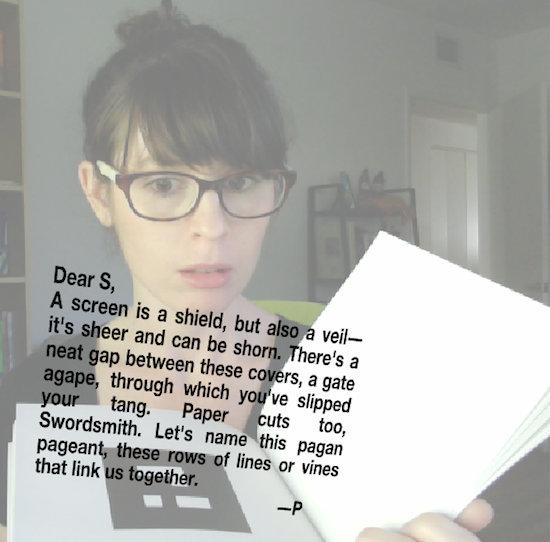 This summer, Alex Saum-Pascual, DH Fellow and Assistant Professor of Spanish and Portuguese, is working on bringing the electronic literature community to campus. Saum-Pascual was recently awarded a Digital Humanities at Berkeley New Course Grant for her proposed undergraduate course, “Electronic Literature: A Critical Writing & Making Course.” Building on rich connections and collaborations formed at the Digital Humanities Summer Institute at the University of Victoria, Professor Saum-Pascual has brought electronic literature to campus through her teaching, her mentorship, and a forthcoming collaboratively curated exhibit, No Legacy || Literatura electrónica. No Legacy will explore the influence of Spanish and Latin American authors in the formation of electronic literature, complicating histories of electronic literature that often center its origins in English language works. Earlier this year, Saum-Pascual was awarded a Hellman grant for her collaborative project, “Hispanic Legacies: The Trace of Experimental Writing in Spain and Latin American (An Electronic Literature Project)“, which debuted at the Asociación Argentina de Humanidades Digitales-AAHD last November.
This summer, Alex Saum-Pascual, DH Fellow and Assistant Professor of Spanish and Portuguese, is working on bringing the electronic literature community to campus. Saum-Pascual was recently awarded a Digital Humanities at Berkeley New Course Grant for her proposed undergraduate course, “Electronic Literature: A Critical Writing & Making Course.” Building on rich connections and collaborations formed at the Digital Humanities Summer Institute at the University of Victoria, Professor Saum-Pascual has brought electronic literature to campus through her teaching, her mentorship, and a forthcoming collaboratively curated exhibit, No Legacy || Literatura electrónica. No Legacy will explore the influence of Spanish and Latin American authors in the formation of electronic literature, complicating histories of electronic literature that often center its origins in English language works. Earlier this year, Saum-Pascual was awarded a Hellman grant for her collaborative project, “Hispanic Legacies: The Trace of Experimental Writing in Spain and Latin American (An Electronic Literature Project)“, which debuted at the Asociación Argentina de Humanidades Digitales-AAHD last November.
When we interviewed Saum-Pascual, she had just returned from DHSI’s inaugural “Advanced Criticism and Authoring of Electronic Literature” course, the result of a steadily growing community of electronic literature scholars at DHSI. The e-lit community at DHSI first gathered as an unconference, a spontaneously organized event, meeting during a lunchtime session to receive a short introduction to the field of electronic literature. In 2014, DHSI offered an introduction to the research and practice of electronic literature as the institute’s 5-day intensive courses. There, Saum-Pascual and her collaborator, Élika Ortega, discussed During the course’s curation unit, Saum-Pascual and Ortega conceived of No Legacy || Literatura electrónica.
No Legacy highlights the rich opportunities for collaboration that curation and digital projects present. Debuting in spring 2016, the exhibit will be installed in Doe Library’s exhibition space. Performing electronic literature also requires securing machines for displaying and interacting with works in their original context. This has involved challenges like hunting down a Macintosh Classic and working with the Bancroft Library’s Digital Collections team to extract and duplicate works originally published on floppy disk. Students in Stephanie F. Lie’s “New Media 290-003: Archive, Install, Restore” will approach the exhibition space from several angles, working with building interactive displays and furniture for the physical space and the print and online materials to accompany the event.
When discussing the difference between her curation practice and more traditional textually-centered research, Saum-Pascual noted that her practice-based research highlighted the “very material and contextual” aspects of literature. “You never think of literature and amps, but we we also need to be thinking of what machines we need to be find, buying, and locating for these particular works. We’ve faced a lot of archival and preservation issues...Dealing hands-on with this project has affected my thinking from a very material perspective. Literature is a very plastic thing, a very real, physical thing that is embedded in a particular context and dated to certain media,” Saum-Pascual noted.
Saum-Pascual’s work also shapes her teaching in the classroom, with offerings in the Spanish and Portuguese Department such as her graduate seminar, “Electronic Literature: Hispanic Influences and Digital Theories”, and her forthcoming Spring 2016 undergraduate course, “Electronic Literature: A Critical Writing & Making Course.” In this special topics class, undergraduates will write critical essays in both Spanish and English on aspects of electronic literature such as, changes in authorship models (cyborg authorship and posthumanism, for example), questions of originality (unoriginal genius, remix, etc), challenges in textual ontology (code ontology vs. print ontology), among others. Students will gain the skills to build their own digital art pieces in a collaborative workshop setting, learning basic programming skills and DH tools and methods. Students’ interactive works will be installed in No Legacy at the conclusion of the class.
Stay tuned for more dispatches from DH at Berkeley and the Berkeley Center for New Media as the exhibit draws near.
Image: Alex Saum teaches Between Page and Screen, an augmented-reality book of poems, to her graduate seminar: Spanish & Portuguese 285: “Electronic Literature: Hispanic Influences and Digital Theories”